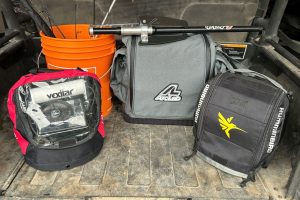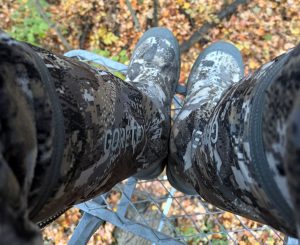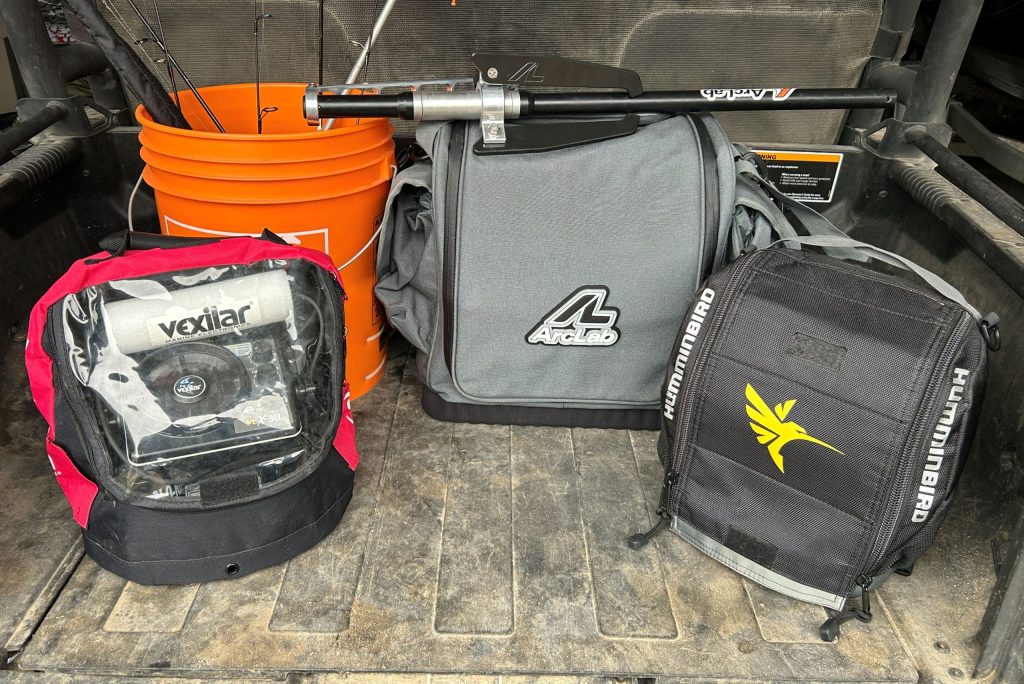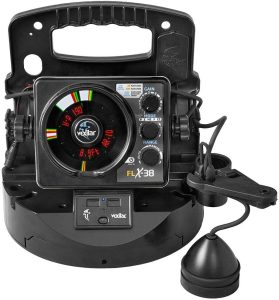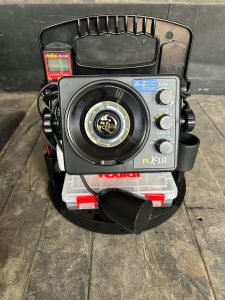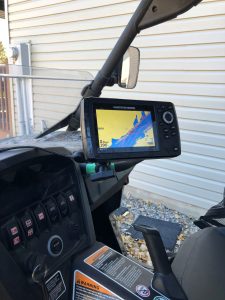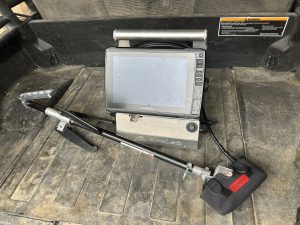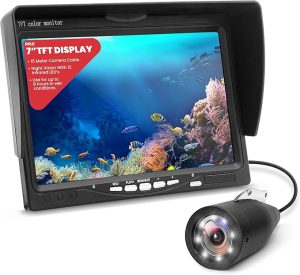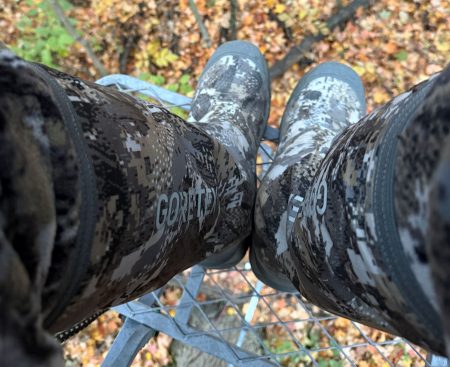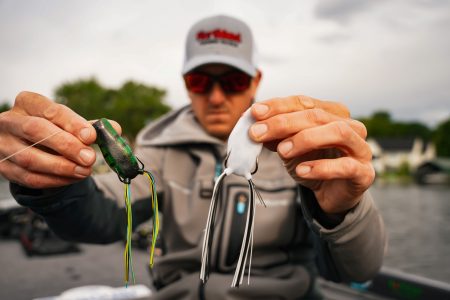I grew up icefishing with my dad and have been hitting the ice each winter for over 50 years in search of fish. In the early years, we used and adapted open-water fishing gear for ice fishing. Over the years, icefishing has grown in popularity, and as a direct result, so have the products and product lines explicitly aimed at creating the best ice fishing fish finders. There have been major advancements in clothing, fishing tackle, electronics, rods, reels, and augers. Of all those items, the introduction and growth of electronics has to be one of the most incredible product developments and advancements I’ve ever seen for icefishing. So much so that if I forget my electronics at home when heading to the lake, I’ll head back for them instead of continuing on to the lake.
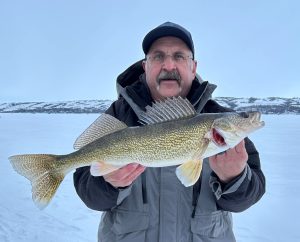
How I Tested These Ice Fishing Electronics
Over the years, I have used a variety of styles and brands of ice fishing electronics. During these outings, I use them from daybreak to past sunset. I often use multiple units on an outing for jigging, setting up dead-sticks, and even navigating and finding fishing locations, including ledges, drop-offs, and sunken islands.
These units were not tested side by side in a one-day science experiment; they are tested over time, with long hours on the ice and use and abuse, as durability is a major factor in determining best value. I regularly fish the lakes in my home province of Saskatchewan, with Last Mountain Lake being my home lake. While fishing these lakes, I target walleye, perch, pike, and burbot. The majority of my fishing is done at depths of 6-30 feet.
For the most part, these lakes are murky and cloudy, and this does not seem to affect the units’ readouts. With the flasher units, underwater haze can be reduced by turning down the gain, and with the sonar units, sensitivity adjustments can filter out the smaller particles I don’t want to see.
During my testing, I fish in all kinds of conditions, ranging from -30 to almost 40 degrees, come late spring, just before ice out. The only impact temperature has on these units is the amount of battery life they consume. LED acid batteries will typically make it through the day on all of the units below, even down to -30, but they will require charging that night and may require switching to dimmer screens or lower power modes on the worst days. Lithium batteries will often run two or more days even under extreme conditions.
These units are often transported long distances on ATVs in sub-zero weather. On some outings, they run outside all day long. On other occasions, they are used inside a heated shack. Over time, I’ve determined which units can withstand the elements, retain battery power all day, and, most importantly, help me find and see fish to catch.
These units perform equally well in ice shelters and outside them. Inside shelters, the screens are protected from the sun and easier to read without glare.
I went out and purchased each of these with my own money; there are no biases or sponsorships in this review.
Below are my choices for Selected Winners in the Best Overall, Best Value, Best Bang for Your Buck, and Best Sonar categories, as well as the editor’s selection for best underwater camera. Click any of the links to shop the lowest price found on the internet:
-
Best Overall Ice Fishing Fish Finder: Vexilar FLX 38BB (Buy on Amazon / Buy at Scheel’s)
-
Best Value (best bang for buck): Vexilar FLX18
-
Best for Mapping/Navigation: Helix 5 & Helix 7
-
Best Ice Fishing Sonar / Best for Ice & Open Water: Garmin Livescope
-
Best Underwater Camera for Ice Fishing: Pyle Underwater Fishing Camera Editor’s Choice
Best Overall Fish Finder for Ice Fishing: Vexilar FLX 38BB
My choice for best overall on ice electronics is the Vexilar FLX 38BB. This lithium-powered flasher unit features 15 broadband sonar frequencies and 300 interference-rejection options. It has an adjustable variable-zoom window, from 6 ft to 18 ft wide, covering the entire water column, allowing you to split the screen to see the whole water column on one side and your selected range on the other. It has a depth-setting variable from 5 ft to 30 ft, in 1-ft increments, for shallow-water detail. It features seven power levels to match any fishing situation. All while giving you live information below and having a mere ¼” target separation.
What makes these units so unique is that they let you adjust the sonar frequency to specific fishing situations. The standard rule with frequency is that the lower the frequency, the wider the beam angle, and the higher the frequency, the narrower the beam angle. While the most common frequency of flashers is 200kHz, the frequency on these units can be set to 160, 170, 180, 190, 200, 210, 220, 230, 240, 250, 260, 270, 280, 290, or 300kHz. With variable frequencies, you can get a wider or narrower beam, which can prove beneficial when fishing on a ledge, so you only get one bottom return and use the various frequencies to see more or less detail downhole. These units also have night mode, 300 interference-rejection modes, and different color-scheme options.
Given all the features available on these units, they are my top choice for flashers.
Pros
- Easy start-up
- Easy to learn basic functions
- Excellent target separation
- Easy to operate dials even with gloves on
- Extremely adaptable with multiple power and frequency modes
- Built-in USB Ports
- Comes with Lithium Battery
Cons
- Learning curve required to operate/change various options
Best Value (best bang for buck): Vexilar FLX18
The Vexilar FLX 18 is a new flasher unit for this year. For years, Vexilar made an FL-18 unit that was a perfect flasher for both beginner and experienced anglers. Like its predecessor ,this new unit is extremely easy to use and operate. It’s ready to go as soon as it’s turned on.
These units have a 12 Degree transducer, which is equivalent to 200 kHz. Like all Vexilar units, this unit provides ¼” target separation. These units feature low power mode, high power mode and two zoom zones. When using the deep-water range, the FLX-18 can reach 300 feet. The zoom zones allow you to focus on the bottom 6 feet or 12 feet, depending on your preference. Night mode and the three-color palette selection make customizing the display quick and easy.
A lead-acid battery powers them and will run all day. There are two versions of this new flasher available. The base model comes on a square blue Genz Pack mount. For $20 more, the Pro Pack unit comes on a black round base and includes a handy digital depth/battery gauge and a small tackle box.
Pros
- Easy to operate
- 1/4” target separation
- Has bottom zoom
- Comes with LED Acid battery
Cons
- Doesn’t have all the Vexilar features
- Need to recharge battery after each day to ensure enough power for next day outing
Best for Mapping/Navigation: Helix 5 & Helix 7
If you’re looking for an icefishing electronics unit, that will help you navigate on the ice, look no further than the Helix 5/7 models. Chances are you may already have one in your boat, and by purchasing a Humminbird Ice Conversion kit, you get a shuttle, carrying case, and ice transducer that allows you to use the unit as a flasher, in a 2D sonar mode, along with the mapping feature. The maps can be purchased, or you can make them yourself during open water season. In fact, I have made small maps of new lakes while icefishing by drilling a series of holes and putting the transducer down those holes
I have a Helix unit mounted to the dash of my Can-Am Commander Side by Side. I use that unit exclusively for navigating to and from my cabin to ice-fishing locations and for accessing waypoints to favorite fishing locations. When using this unit for navigation, I can pull up to a spot and drill holes in the exact depth I want to fish, which saves me time and effort so I can focus on fishing. The mapping feature with tracking has allowed me to safely get off the ice when unexpected snowstorms or fog roll in.
These units use CHIRP sonar, which results in good target separation and detailed graphics. If fishing in warmer weather for short periods of time, a lead-acid battery will be just fine with these units. However, if fish all day or in cold weather, I would suggest investing in a lithium battery.
Pros
- Excellent mapping
- Can be used as a flasher or in 2D mode
- Good Target Separation
- Versatile – can use open water and ice fishing seasons
- Portable
Cons
- Uses lots of battery power
- Screen can be hard to read on sunny days
- Need to remove gloves to operate
- Need to buy shuttle and ice transducer
- Need to buy battery
Best Sonar for Ice Fishing / Best for Ice & Open Water: Garmin Livescope
In my opinion, the absolute best sonar for ice fishing is a Garmin Livescope setup because this technology lets you see your lure, fish, and structure in a 360-degree circle up to 100 feet around you by simply turning your transducer. If fish are underneath you, you can watch your lures and see how they react to your offerings. If fish are in the distance, you can move that way and punch holes directly over those fish. The details of the sonar images you see are so accurate that, with a bit of screen time practice, you can determine species below and know exactly which way they are moving.
The LVS 34 is Garmin’s latest LiveScope transducer and uses their GLS 10 black box to tie the sonar images from the transducer to a chart plotter, also known as a screen. There are numerous options for chart plotters to suit every budget and space requirement. I went with a 10″ Echomap Ultra2 106SV for my screen. I upsized to the 10-inch screen because the detail is much easier to see than on an 8- or 9-inch model. I went with a 10-inch screen over a 12-inch model because it made the setup a little more compact and was approximately $800 cheaper.
What I like to do when ice fishing is drill a main hole and drop my Live Scope transducer down. I will then drill a series of holes approximately 5 feet apart in lines leading away from my main hole. If fish are spotted directly below me, I’ll fish and watch the screen. If distance fish are spotted, I will move to one of those holes and fish it with a flasher unit.
The beauty of a Live Scope unit is that, when set to down mode, two anglers can watch their lures on the screen, making it ideal for fishing in an ice shelter.
Given the value of Live Scope setup, I wanted a shuttle that helped protect the unit, while at the same time made it easy to carry. As a result, I went with the Arclab 5200 series shuttle as it is designed specifically to hold the screen and black box along with a battery. For further protection, I carry the entire shuttle in an Arclab 5200 carrying case. Speaking of batteries, I power my set up with an Amped Outdoors 12V 30AHLithium Battery as it powers the unit all day on even the coldest of days
Pros
- Extremely accurate – can see lures, fish, and structure all around you
- Fish detail is so accurate that over time you can determine species, and see which way they are moving
- Detailed target separation
- Can see the tiniest of hooks in depths over 30 feet
Cons
- Expensive
- Cumbersome and heavy
- Lengthy learning curve to fully read and understand what is happening downhole
- Hard to use in the same hole being fished
- Need bare hands to operate the touch screen
- The screen can be hard to operate with cold/wet fingers
- Need to buy a battery
Best Underwater Camera for Ice Fishing: Pyle Underwater Fishing Camera (Editor’s Choice)
Ice-fishing presents some unique challenges: very low light, cold temperatures, rough handling, and the need to monitor beneath the ice efficiently. This Pyle system hits many of those marks. First, it features a 1000 TVL resolution camera and 12 infrared LEDs, which means you’ll get decent image clarity and the ability to see in dim or dark underwater conditions (common under ice).
Second, its waterproof rating (IP68) and sturdy construction mean it’s built for hard use.
Third, the system is portable (monitor + camera + cable) and designed for fishing rather than generic underwater inspection, which aligns well with ice-fishing setups where mobility and quick deployment through a drill hole matter. The long cable options (up to ~15 m in some models) also give flexibility for deeper holes or variable conditions.
Finally, the inclusion of a sun-visor on the monitor and a monitor tailored for outdoor use means you’ll have usable viewing in bright snow/ice glare conditions, which many cheaper units ignore.
Put all together: good image quality, night-vision capability, built-for-fishing design, and rugged enough for ice conditions — these make it stand out in the “underwater camera for ice fishing” category.
Pros
-
Excellent low-light/infrared capability – 12 IR LEDs allow visibility beneath the ice where ambient light is minimal.
-
High resolution sensor (1000 TVL) gives clearer image of fish, structure, and movement underwater.
-
Rugged, waterproof (IP68) build suited for cold, wet, abrasive conditions.
-
Cable length options allow flexibility for deeper holes or more drop.
-
Monitor designed for outdoor use (sun-visor, portable form) — helpful in glare-intense ice/snow environments.
-
Designed with fishing/underwater observation in mind rather than generic inspection use.
Cons
-
At 1000 TVL and with a basic monitor, image clarity might still lag behind high-end specialized ice-fishing camera systems (which may support full HD video or freeze-resistant electronics).
-
The system likely comes with bulk (monitor + camera + cable + battery) – in tight ice shanties or on mobile setups, size/weight may matter.
-
Battery life in extreme cold may be reduced significantly compared to manufacturer specs (as happens with most electronics in freezing temps).
-
Depending on model, the cable and electronics may still need special care to avoid ice build-up or freezing of exposed connectors — might require extra prep/maintenance.
-
There may be cheaper units that cover the basic “see fish under ice” need, so this might represent higher investment than minimal use requires.
Why Electronics Matter for Ice Fishing Success
For decades, ice anglers relied on instinct, memory, and trial-and-error to find fish beneath a frozen lake. Today, electronics have completely reshaped that experience. After more than 50 years on the ice, I can confidently say no single category of gear has improved success — and overall enjoyment — more than modern sonar, mapping units, and underwater cameras. Electronics have taken much of the guesswork out of the sport, helping anglers fish smarter, safer, and far more efficiently.
The biggest advantage is simple: electronics show you what’s happening beneath the ice in real time. Whether you’re running a traditional flasher, a high-resolution sonar, or a live-scanning system like LiveScope, you can see fish move, react, and feed long before you ever feel a bite. This feedback changes everything. You can adjust lure action, shift depths, switch presentations, or move holes entirely — all based on immediate information. Instead of blindly hoping fish pass through, you’re fishing with purpose.
Electronics also help you locate and stay on a productive schedule. Mapping units like the Humminbird Helix series allow anglers to pinpoint ledges, humps, weed edges, and drop-offs with precision. This ability to return to exact waypoints — even in low visibility, snowstorms, or fog — means more time fishing and less time wandering across the ice drilling unnecessary holes.
Another major benefit is efficiency. Modern sonar helps you avoid unproductive areas and focus on where the fish actually are. If a flasher or live sonar shows empty water, you move. If you see suspended fish or bottom-hugging marks, you adjust instantly. When temperatures drop below zero and hole-hopping becomes a chore, this efficiency keeps you warmer, more comfortable, and ultimately more successful.
Finally, electronics deliver a level of confidence that changes how you fish. Once you experience seeing your lure rise and fall, watching fish chase, hesitate, strike, or lose interest, you learn more in a single day than you once did in an entire season. It accelerates your angling knowledge and transforms each outing into a more rewarding experience.
Simply put: electronics don’t just help you catch more fish — they make every minute on the ice smarter, safer, and far more enjoyable.
FAQs: Ice Fishing Electronics
Do fish finders work under ice?
Yes. Modern fish finders, flashers, and sonar units work extremely well under the ice as long as the transducer has a clear path to the water. Most anglers simply place the transducer down a drilled hole, allowing the sonar beam to read depth, structure, and fish activity in real time. High-frequency units perform best in clear water, while CHIRP sonar offers excellent detail across multiple depths. With proper setup, fish finders are just as effective — often more effective — under the ice as they are during open-water season.
Is LiveScope cheating?
No. Garmin LiveScope provides a significant advantage, but it doesn’t guarantee fish. It simply shows what’s happening around you in real time — how fish move, how they react to your lure, and whether they’re present at all. You still need to drill smart, pick the right presentation, and make the right decisions. Many anglers argue LiveScope accelerates learning and improves efficiency, but catching the fish is still entirely up to you.
What frequency is best for ice fishing?
For most ice-fishing situations, 200 kHz is the standard frequency because it provides a good balance of target separation and beam width. Shallower water or wider coverage can benefit from lower frequencies (160–180 kHz), while deeper water or high-detail scenarios improve with higher frequencies (210–300 kHz). Units like the Vexilar FLX-38BB offer multiple frequencies so anglers can match the beam angle to the exact fishing scenario — a major advantage when fishing ledges or tight structure.
Should beginners buy a flasher or a sonar?
For beginners, flashers are often the easiest to learn because they provide simple, real-time feedback with minimal settings. However, many anglers prefer modern LCD sonar units because they offer history, mapping options, CHIRP detail, and more versatility for open water. If your focus is strictly ice fishing, a flasher is a great starting point. If you fish year-round, a sonar/GPS combo unit like a Helix 5 or 7 may be the better long-term investment.
Do underwater cameras scare fish?
Generally, no. Most underwater cameras are designed with dark, non-reflective housings that blend naturally underwater. In clear water or around cautious species, slight camera movement or infrared lights can occasionally spook fish, but this is rare. Most anglers find cameras incredibly useful for observing fish behavior, evaluating lure action, and identifying species — all without negatively affecting catch rates.
Conclusion
As mentioned at the beginning, I would never go ice fishing without any electronics. I say this because they bring so much to the game, giving me information and helping me see and understand what is happening downhole. Without a doubt, they help me catch more fish and have more fun doing so.
I highly recommend you utilize some form of electronics in your next ice fishing excursion, and read more on tips for using a Vexilar if that’s your selection. While looking at the units, see what suits your budget, fishing style, storage/carrying requirements, and choose your unit or units accordingly. From my experience, all of the above units will make your icefishing more enjoyable and successful.
Per our affiliate disclosure, we may earn revenue from the products available on this page.

